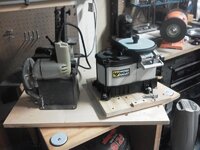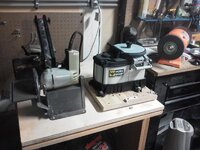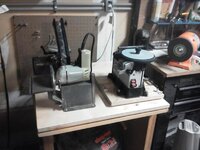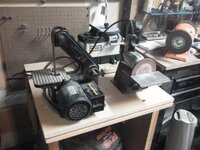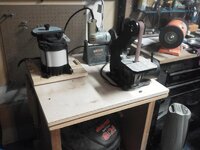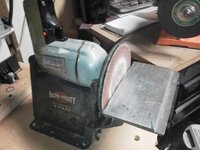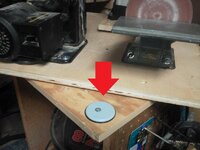andrewleeheck
Member
Ok, no microphone. However, I created a sanding/sharpening workstation with two lazy susans mounted to a removable top, which rests on an old hollow rolling cart (it used to be a makeshift construction site hot dog stand!).
The top is made of two 24" square sheets of 3/4" baltic birch plywood with 12" lazy susan hardware sandwiched in between--all from a big box store. Two cleats beneath the bottom layer secure any side-to-side movement, while allowing the top assembly to be slid out the front (I have 6 of these interchangeable bases in my shop, each with a different benchtop tool mounted on it).
I affixed a second lazy susan--6", same store--to the top layer on an 11" square base. The WorkSharp 3000 sits on the smaller base. The reason for incorporating this smaller turntable is that it allows me to rotate the WS in order to accommodate different approach angles for different tools. For example, ordinarily you must stand on one side of the machine to use the top tool rest, another to use the chisel port, and yet another to use the slotted wheel underside approach.
The other mounted tools include a 1" stationary belt sander (great for removing material) and a mounted hand drill with a disc sanding attachment and rest (a wonderful and nostalgic flea market find--great for squaring blanks).
Both the large worktop and the smaller base have carefully drilled holes that fit their respective clevis pins, allowing me to lock the surface in place while working. I also mounted an outlet strip on the back of the cart. So far, the only challenge I'm having is the hassle of managing the cords as I rotate the tabletop, but this is only a minor issue and is far outweighed by the great workspace it provides.
**I HIGHLY recommend incorporating some sort of shims between the top (rotating) and base (fixed) layers to support the top's corners--too much pressure on one corner could damage the turntable mechanism. I used the smooth-topped plastic furniture sliders, as the height and surface worked perfectly with the dimensions of my worktable. The red arrow in the picture points to one of them, and I used one for each corner.
I plan to modify the hollow space inside the cart to house accessories for the mounted tools, and may try to integrate my rotary tool and bits into the whole thing somehow. Thanks for looking! Feedback and related ideas are warmly welcomed!
Andrew
The top is made of two 24" square sheets of 3/4" baltic birch plywood with 12" lazy susan hardware sandwiched in between--all from a big box store. Two cleats beneath the bottom layer secure any side-to-side movement, while allowing the top assembly to be slid out the front (I have 6 of these interchangeable bases in my shop, each with a different benchtop tool mounted on it).
I affixed a second lazy susan--6", same store--to the top layer on an 11" square base. The WorkSharp 3000 sits on the smaller base. The reason for incorporating this smaller turntable is that it allows me to rotate the WS in order to accommodate different approach angles for different tools. For example, ordinarily you must stand on one side of the machine to use the top tool rest, another to use the chisel port, and yet another to use the slotted wheel underside approach.
The other mounted tools include a 1" stationary belt sander (great for removing material) and a mounted hand drill with a disc sanding attachment and rest (a wonderful and nostalgic flea market find--great for squaring blanks).
Both the large worktop and the smaller base have carefully drilled holes that fit their respective clevis pins, allowing me to lock the surface in place while working. I also mounted an outlet strip on the back of the cart. So far, the only challenge I'm having is the hassle of managing the cords as I rotate the tabletop, but this is only a minor issue and is far outweighed by the great workspace it provides.
**I HIGHLY recommend incorporating some sort of shims between the top (rotating) and base (fixed) layers to support the top's corners--too much pressure on one corner could damage the turntable mechanism. I used the smooth-topped plastic furniture sliders, as the height and surface worked perfectly with the dimensions of my worktable. The red arrow in the picture points to one of them, and I used one for each corner.
I plan to modify the hollow space inside the cart to house accessories for the mounted tools, and may try to integrate my rotary tool and bits into the whole thing somehow. Thanks for looking! Feedback and related ideas are warmly welcomed!
Andrew
Attachments
Last edited:

